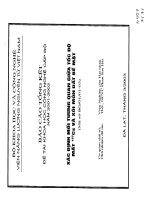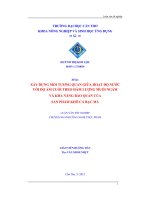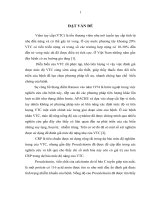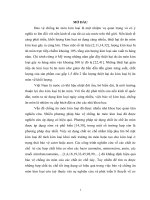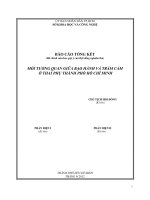Điều tra về mối tương quan giữa thái độ học tập và khả năng nghe hiểu của sinh viên trường Đại học Kinh Doanh và Công Nghệ
Bạn đang xem bản rút gọn của tài liệu. Xem và tải ngay bản đầy đủ của tài liệu tại đây (1.29 MB, 68 trang )
VIETNAM NATIONAL UNIVERSITY, HANOI
UNIVERSITY OF LANGUAGES AND INTERNATIONAL STUDIES
FACULTY OF POST-GRADUATE STUDIES
*** ***
NGÔ THỊ XUYÊN
AN INVESTIGATION INTO THE CORRELATION BETWEEN
LEARNERS’ ATTITUDES TOWARDS LEARNING LISTENING
AND THEIR LISTENING PERFORMANCE AT HANOI
UNIVERSITY OF BUSINESS AND TECHNOLOGY
(Điều tra về mối tương quan giữa thái độ học tập và khả năng nghe
hiểu của sinh viên trường Đại học Kinh Doanh và Công Nghệ)
M.A MINOR THESIS
Major : English Teaching Methodology
Code : 60 14 10
Hanoi, 2013
VIETNAM NATIONAL UNIVERSITY, HANOI
UNIVERSITY OF LANGUAGES AND INTERNATIONAL STUDIES
FACULTY OF POST-GRADUATE STUDIES
*** ***
NGÔ THỊ XUYÊN
AN INVESTIGATION INTO THE RELATION BETWEEN
LEARNERS’ ATTITUDES TOWARDS LEARNING LISTENING
AND THEIR LISTENING PERFORMANCE AT HANOI
UNIVERSITY OF BUSINESS AND TECHNOLOGY
(Điều tra về mối quan hệ giữa thái độ học tập và khả năng nghe
hiểu của sinh viên trường Đại học Kinh Doanh và Công Nghệ)
M.A MINOR THESIS
Major : English Teaching Methodology
Code : 60 14 10
Supervisor: Dương Thu Mai, Ph.D
Hanoi, 2013
i
DECLARATION
I hereby certify that this thesis is entirely my own work. I have provided
fully documented references to the others‟ work. The material in this thesis has not
been submitted for assessment in any other formal course. I also accept all the
requirements of University of Languages and International Studies relating to the
retention and use of M.A Graduation Thesis deposited in the library.
ii
ACKNOWLEDGEMENT
This thesis would not be fulfilled without the help of some people, and in
some ways, I would like to thank everyone who has taught me, inspired me,
challenged me, and supported me throughout the realization of this thesis.
I would like to express my deepest thanks to my beloved supervisor, Duong
Thu Mai, Ph.D, for her whole-hearted assistance, encouragement as well as the
profound guidance she gave me while I was doing my research.
I would like to take this opportunity to express my gratitude to all lecturers
in Faculty of Post-graduate Studies, University of Languages and International
Studies, Vietnam National University, Hanoi for their interesting lectures which
have inspired me to conduct this thesis.
I would also like to express my thanks to the teachers of English, freshmen
and second-year students at Faculty of Accountancy and Management at Hanoi
University of Business and Technology for their willingness to participate in the
research. Without their help, this project could not be fulfilled.
Last but not least, I am most thankful to my relatives who have always
inspired and encouraged me to complete this study.
Hanoi, December 2013
Ngo Thi Xuyen
iii
ABSTRACT
This paper reports the result of the study that aimed at identifying first-year
and second-year students‟ attitudes towards learning listening and the relation
between these attitudes and learners‟ listening performance at a university in Hanoi.
Three issues, hence, are investigated: (1) the attitudes towards learning English in
general and learning listening in particular; (2) the differences between two groups
of students in terms of their attitudes; and (3) the correlation between the attitudes
to learning listening and their listening performance.
The findings based on a survey with 130 students reveal that there was an
interest in learning English, but listening lessons and tasks, and course objectives
beyond their level was a barrier to learning English. A lot of the assistance from the
teacher with explanation on test format and scoring was appreciated. However, that
they listened to no materials but listening sections in the course books is a hindrance
to their listening performance. Though admitting that their listening results can
influence their future performance, students‟ gradual improvement in listening
result was not ensured.
Secondly, there was a distinction between first-year and second-year students
regarding the acknowledgement of difficulties with listening comprehension, test
relevance to the course objectives, teachers‟ explanation to the test scoring criteria,
and the agreement on the stimulation of good listening results over their later
performance.
Thirdly, no strong correlation between attitudes and listening performance
was found. There are many other factors that contribute to listening performance
like the reliability of the test, teachers‟ teaching style, and so on.
iv
LIST OF ABBREVIATION TERMS
HUBT
Hanoi University of Business and Technology
SD
Strongly disagree
D
Disagree
N
Neutral
U
Undecided
A
Agree
SA
Strongly agree
L2
Second language
ID
Identity
SLA
Second language acquisition
SPSS
Statistical Package for the Social Sciences
ELT
English language teaching
Q
Question
v
LIST OF TABLES AND FIGURES
Page
Figure 1:
Range of student attitudes towards target language
9
Figure 2:
Range of attitudes to learning L2 expressed as learning outcomes
9
Figure 3:
Representation of Socio-educational Model of SLA
15
Figure 4:
Atttitudes towards learning English and learning listening
27
Figure 5:
Attitudes towards listening lessons, question 4 and 7
27
Figure 6:
Attitudes towards listening lessons, question 5, 6 and 9
28
Figure 7:
Attitudes towards listening lessons, question 8 and 10
29
Figure 8:
Attitudes to tests
29
Figure 9:
Attitudes to teachers interms of teaching content
30
Figure 10:
Attitudes to teachers regarding scoring
31
Figure 11:
Attitudes towards materials
32
Figure 12:
Attitudes to listening performance
32
Table 1:
Results of Mann Whitney U Tests on the Differences between Year 1
Students and Year 2 Students in the Attitudes toward Learning Listening
33
Table 2:
Results of Spearman Rho Tests on the Correlation between Students'
Listening Learning Attitudes and Listening Performance
35
vi
TABLE OF CONTENTS
Declaration i
Acknowledgement ii
Abstract iii
List of abbreviation terms iv
List of tables and figures v
PART A: INTRODUCTION 1
1. Rationale 1
2. Aims of the study 2
3. Research questions 3
4. Scope of the study 3
5. Method of the study 3
6. Design of the study 4
PART B: DEVELOPMENT 5
CHAPTER I: Literature Review 5
1.1. Learner factor/ (Affective factors which affect English learning performance) 5
1.2. Learning attitudes 6
1.2.1. Definition of learning attitudes 6
1.2.2. Classification of learning attitudes 7
1.3. Differences between motivation and attitude 10
1.4. Learning performance 12
1.4.1. Learning performance in English Language Teaching 12
1.4.2. Learning performance in listening 13
1.4.3. Assessing listening performance 13
2.1. Theories on the relation between attitudes and performance 15
2.2. Studies on the relation between attitudes and performance 16
CHAPTER 2: METHODOLOGY 19
2.1 Context of the study 19
2.2 The study 21
2.2.1. Participants 21
vii
2.2.2. Data collection instruments 21
2.2.3. Data collection procedure 22
2.3. Data analysis 23
2.3.1. Analysis techniques 23
2.3.2. Data presentation and analysis 24
CHAPTER 3: FINDINGS AND DISCUSSIONS 26
3.1. Students‟ attitudes to learning listening (research question 1) 26
3.1.1. Attitudes to learning English and learning listening 26
3.1.1.1. Attitudes towards learning English and learning listening 26
3.1.1.2. Attitudes towards listening lessons 27
3.1.1.3. Attitudes to tests 29
3.1.1.4. Attitudes to teachers and materials 30
3.1.1.5. Attitudes to listening performance 32
3.2. The differences in attitudes of the two groups towards learning listening
(research question 2) 33
3.3. The correlation between listening attitudes and listening performance (research
question 3) 34
PART C: CONCLUSION 40
1. Conclusion 40
2. Recommendations 40
3. Limitations 41
REFERENCES 43
Appendix 1 I
1
PART A: INTRODUCTION
1. Rationale
Listening skill is a critical dimension in language learning in general and in
learning English as a foreign language in particular (Kurita, 2012). This input skill
plays a vital role when communicators exchange information. It is clear that once
mastering this skill, students can carry out the conversation with other people, state
their ideas and exchange the information (Rost, p 94).
For this importance, learners try their best to improve their English listening
competence; however, few students have succeeded. A large number of students
after a long time learning English find it difficult to listen to dialogues, recording, or
to native speakers. Hence, according to Kurita (2012), a lot of research addressing
various issues in learners‟ low achievement has been carried out.
Learning a language, especially listening to it, is considered a complex
process, which is often affected by many factors such as attitude, motivation, age,
intelligence, learning environment, etc. These variables have been researched to see
how they affect an individual learner‟s response to the task of learning a L2 (Ellis,
1985). Of these contributing factors, attitude, regarded as a positive or negative
disposition toward an object, situation, or behavior, is believed to have great impact
on success or failure of a language learner (Burstall, 1975). As cited in Gardner‟s
book (1985), learner attitude has become key issues in language learning in general,
and the subject of many studies for a long time.
In Vietnam, English is considered as an indispensable subject in all
universities‟ curriculum. Communicating in English or being competent in English
is considered a preferable tool to make learners understood in a workplace context,
or have an advantageous job over the others.
At Hanoi University of Business and Technology (hereafter HUBT), a
private university, English is a compulsory subject for all students of all faculties.
For freshmen who have not been familiar with the ways of studying at university,
attending two or three English classes a week makes English a burden. However,
2
the question about whether they are fully aware of the importance of learning
English, especially learning listening is left unanswered in this context. Also, the
transition from the first to the second school year does not seem to mean great
changes in students‟ listening skill and listening performance. Besides, listening
results which are seen as a tool to evaluate their progress are not up to teachers‟
expectations and to the course‟s objectives. The reasons for these symptoms,
therefore, need more explanation.
Recently in Vietnam, although motivation and attitudes has been the subject
of many studies (Đỗ, 2011; Nguyễn, 2011, et al), the correlation between learners‟
attitudes towards learning listening and their listening performance has not been
investigated. Also, at the Department of English- Hanoi University of Business and
Technology, there have been no attempts in investigating this issue. Regarding the
critical relation between attitude and language learning, it is greatly important to
research the matter intensively.
The aforementioned reasons have encouraged the writer as a teacher of
English at English Department at HUBT to explore this matter so as to find out how
learners‟ attitudes towards listening and their listening performance correlate.
Hopefully, the results of this research could contribute to completing the insightful
understanding about learners‟ attitudes, to enhance teaching and learning English at
the institution, and to lay a foundation for subsequent research.
2. Aims of the study
The study is to investigate the relation between learners‟ attitudes towards
learning listening and their listening performance. Surveying the first-year and
second-year students, the author firstly aimed at identifying their general attitudes
towards learning English, and towards learning listening as the main focus of the
study. Besides, the study examines how two groups of students differ in their
attitudes. Finally, the question whether their attitudes correlate with their
performance will be answered.
3
3. Research questions
In order to achieve the above-mentioned aims, the following research
questions are raised in the study:
1. What are students‟ attitudes in/ towards listening?
2. How do different groups of students differ in their attitudes?
3. To what extent do students‟ attitudes correlate with their performance?
4. Scope of the study
Learning attitudes and listening performance are broad topics, and they
cannot be wholly discussed within the framework of this paper. Thus, this minor
thesis attempts to investigate only the targeted students‟ attitude towards learning
listening to English and the correlation between that attitude and their listening
performance.
The subjects of the study include 130 students at the Department of
Accountancy and Management at HUBT who are not English majored but learning
listening skills according to the Communicative language teaching approach.
Therefore, the results of this study may be generalized to all Vietnamese non-
English majors.
5. Method of the study
This study employs both qualitative and quantitative research methods in
order to get a more detailed and comprehensive picture about what is investigated.
A survey questionnaire was used with 65 freshmen and 65 second-year
students in the Faculties of Accountancy and Management to collect information on
their attitudes towards learning English and listening, and to gather the
recommendations on how to learn listening successfully.
The qualitative research method involves the constructing and validating of
the questionnaire. Firstly, the literature review of the study relies on thorough
document analysis of related theories and research on ELT listening and attitudes.
Moreover, teachers at the HUBT were invited to state their opinions in paneling the
questionnaire before it was revised for surveying purpose.
4
6. Design of the study
This study is composed of three following parts:
Part A: Introduction presents the background, aims, research questions, the
significance, the scope, and the design of the study.
Part B: Development is organized in three chapters as follows.
Chapter 1- Literature review, conceptualizes the framework of the study
through the discussion of issues and ideas on theories of learners‟ attitudes towards
listening and listening performance.
Chapter 2 - Methodology, presents the context, the methodology used in this
study including the context, the subject, the data collection instruments, data
collection procedure, and data analysis.
Chapter 3 – Findings and Discussions consists of a comprehensive analysis
of the data and a discussion on the findings of this study.
Part C: Conclusion offers a summary of the findings, recommendations,
limitations, and future directions for further study.
5
PART B: DEVELOPMENT
CHAPTER I: Literature Review
In this chapter, the researcher will present some theoretical backgrounds that
necessitate the realization of this research and helps provide the related literature for
the study. First, it reviews some learner factors that researchers have investigated
and found out to be related to learning. Then the most suitable definitions of
learning attitudes are presented among many definitions. This chapter also
differentiates motivation and attitudes towards learning before showing most
attention to learners‟ attitude towards learning. Second, some theories related to the
main aim of the study are presented to persuade readers and people who are
interested in this matter with some studies done by scholars in the world. Then the
relation between learners‟ attitudes towards learning listening and listening
performance would be determined.
1.1. Learner factor/ (Affective factors which affect English learning performance)
Learning language is a challenging task for learners, especially the ones who
learn English as a foreign language. Undeniably, how to learn a language
successfully depends on many factors. It is said that nearly all the research into the
learner variables has either investigated their effect on the proficiency levels
achieved by different learners, or described how they affected an individual
learner‟s response to the task of learning a second language (L2) (Ellis, 1985).
Petrides (2006) says that foreign language learners vary in terms of such factors as
attitudes, motivation, age, learning style, and aptitude. These factors come to a
notion of and its users, and with their emotional responses. Ellis, however, coined
these affect which is defined by Arnold (1999) as involving “aspects of emotion,
feeling, mood or attitude which condition behavior. Also, Dickinson (1987:25)
characterizes affect as it is concerned with learners‟ attitude towards the target
language factors into a term called general factors. Whatsoever, these scholars
share the same view on the elements which influence on what learners perform.
6
Though contributing to learners‟ success, each of these factors is not a
“unitary construct but a complex of features” (Ellis, 1985). However, this part
provides definitions of some factors that have been seen as contributing causes to
learner‟s performance.
Aptitude is considered as one of these variables. According to Ellis (1985),
it refers to the specific intellectual ability involved in language learning. Similarly,
Carroll and Sapon define aptitude as a complex of “basic abilities that are essential
to facilitate foreign language learning” (cited in Dörnyei, 2005: 23). In line with
this, aptitude as a certain „knack‟ for languages enables best language learners to
perceive languages faster than the others (Lightbown and Spada, 2006).
Also, personality of learners contributes to either the success or failure in language
learning. It encompasses such personal characteristics as extroversion/ introversion, risk-
taking, empathy, tolerance of ambiguity, self-esteem, and need excitement.
Foreign Language Learning theories also advocate that motivation, an
important factor relating to students‟ learning performance can be defined in
relation to two factors- the needs of the learners, and their attitudes towards the
second language and the second language community. Learners are motivated if
they need to learn the language in order to achieve a goal, or if they want to
communicate with the speakers of the target language and learn about the country
where the language is spoken (Nakanishi, 2002). In addition, it is grouped together
with various aspects of personality and emotion.
Though both motivation and attitudes have been taken into consideration,
this study focuses on learning attitudes. Learning attitudes will be discussed in more
details in the section that follows.
1.2. Learning attitudes
1.2.1. Definition of learning attitudes
Savignon (1976:295) claims that “attitude is the single most important factor
in second language learning”. This learning attitude is defined from different angles
ranging from the psychological to educational ones.
7
From psychological stand-point, attitudes refer to evaluative, emotional
reactions (i.e. the degree of like and dislike associated with the attitudinal object)
encompassing three categories, affect, cognition, and behavior. Also, Allport (1954:
45) states that “an attitude is a mental and neural state of readiness, organized
though experience, exerting a directive or dynamic influence upon the individual‟s
response to all objects and situations with which is related”. It is said that attitudes
have cognitive, affective, and behavioral components (cf. Harding et al. 1954) in
which the cognitive component refers to the individual‟s belief structure, the
affective to emotional reactions, and the behavioral to the tendency to behave
toward the attitudinal object, respectively.
From an operational viewpoint, as cited in Gardner‟s book (1985), an
individual‟s attitude is an „evaluative reaction to some referent or attitude object,
inferred on the basis of the individual’s beliefs or opinions about the referent’.
All these views claim that attitudes are responses to an attitudinal object. For
the first view, there is a learned tendency from personal experience or observation
to the attitudinal object to form an attitude. According to Allport, though
accumulated from previous experience, attitude as a mentally ready state directs the
learner‟s reactions to the attitudinal object.
These different views on attitudes have resulted in different ways to classify
attitudes which are presented in the next section.
1.2.2. Classification of learning attitudes
Learning attitudes have been classified in a lot of research. Stern (1983: 367-7)
classifies attitudes into three types: (1) attitudes towards the community and people
who speak the L2; (2) attitudes towards the learning concerned; and (3) attitudes
towards languages and language learning in general. These attitudes are influenced by
the personality of the learner who is either ethnocentric or authoritarian. They may be
influenced by the social milieu in which learning proceeds. Different attitudes; for
instance, may be found in monolingual and bilingual contexts. This study, however,
focuses on the bilingual context where learners learn English as a foreign language.
8
Gardner (1985) mentioned three different ways of classifying attitudes.
Firstly, based on the relationship between the attitude measures and achievement
indices in a second language, attitudes can be classified into specificity and
generality. He exemplifies that attitude toward learning some language is relatively
specific as attitude object or learning that language is circumscribed and definite. A
measure like “interest in foreign languages” is considerably more general. Attitudes
can also be categorized in terms of their relevance to second language achievement.
The last division comes to educational and social attitudes. The former involves
attitudes towards the teacher, the course, learning the language, etc while the latter
encompasses attitudes focusing on the cultural implications of second language
acquisition. His classification, therefore, contributes partly to the way the researcher
categorized the attitudes in the questionnaire design encompassing attitudes to the
teacher and material, to the course which involves the objective and relevance to
students‟ linguistic proficiency, and the learning language.
Later, Stern (1992:88) represents different levels of students‟ attitudes
towards target language in Figure 1. He scales attitudes from the very positive to
very negative rankings of which three sub-levels follow the same direction.
9
Very positive
Positive
Neutral
Negative
Very negative
Be enthusiastic
about L2.
Enjoy 4 skills.
Praise L2
Enter into
spirit of L2.
Feel at home
in L2.
Feel good and
confident
about L2
Recognize,
tolerate, and
accept L2.
Acknowledge
differences and
difficulties.
Have no marked
sense of
discomfort or
disorientation.
Find it hard to
accept L2.
Find L2
strange.
Feel
uncomfortable
and disoriented
about most
aspects of L2.
Feel L2 is odd,
annoying, and
ugly.
Reject L2.
Figure 1. Range of student attitudes towards target language (Stern, 1992: 88)
He also describes learning attitudes to L2 as learning performance
Very positive
Positive
Neutral
Negative
Very
negative
Be
enthusiastic
about L2
Tackle L2 with
confidence and
enjoyment.
Be willing and
co-operative.
Handle
difficulties in a
positive spirit.
Accept L2
without
enthusiasm
Treat L2 as an
unpleasant
task.
Avoid L2.
Be irritated by
L2.
Want to drop
out.
Hate having
to learn L2.
Resist
learning L2.
Figure 2. Range of attitudes to learning L2 expressed as learning outcomes. (Stern, 1992)
10
Besides, students‟ attitudes are believed to vary towards teachers and course
materials. Gardner in his lecture states that attitudes toward the Learning Situation,
involves attitudes toward any aspect of the situation in which the language is
learned. In the school context, these attitudes could be directed toward the teacher,
the course in general, one‟s classmates, the course materials, extra-curricular
activities associated with the course, etc. Underwood (1989: 28) affirms that
teachers play an important role in making sure that lessons proceed in an effective
way so that learners feel safe, relaxed and unthreatened by the listening tasks.
Learners have different expectations of teachers. For example, they expect the
teachers‟ guidance on the test format and ranking so that they are not lost in such
things during the test. Some students do appreciate when teachers make a detailed
revision before the test. These factors will undoubtedly be reflected in the
individual‟s attitudes toward the learning situation if the language teacher does not
perform effectively or in a non-responsive way, or the course is not interesting,
either. Besides, Koch (1975) says that information presentation in teaching
materials can result in the development and perpetuation of learners. The contents
from course materials are important to be adapted; however, they are not varied
enough for some students. In other words, teachers and course materials are two
other important variables which the researcher took into consideration.
To sum up, this section has discussed different aspects of learners‟ attitudes
in learning English. Learners differ in their attitudes towards learning English in
general, and towards materials and teachers in particular.
1.3. Differences between motivation and attitude
In a lot of research, many authors have shown an interest in the relationship
between motivation and attitudes, and learners‟ performance in some learning skills
like reading and speaking. In other words, motivation and attitudes have been two
inseparable common terms though there is still no final agreement on the
relationship between motivation and attitudes. Therefore, this part mainly deals with
the comparison between motivation and attitude.
11
It has been indicated in some research that a number of measures of attitudes
and motivation are related to each other, and to measures of achievement in a
second language. Gardner (1979) suggests that attitudes are related to motivation
since they function as supports of learners‟ overall orientation. Later, Gardner and
his partner, Smythe (1981) in their research, Attitude/ Motivation Test Battery
(AMTB) show a number of variables of motivation which also include attitudes as a
component. Among four categories, the first is motivation, which encompasses
desire to learn a language, intensity of effort to achieve this, and attitudes towards
learning the language. The second is integrativeness which involves attitudes
towards the target language group, and which touches on the affective factor of
ethnocentricity. The third refers to attitudes towards language teachers and the
language course. That is, these two factors are co-related in a sense of extension and
intension.
Also, Lifrieri (2005:14) asserts the importance of attitudes, but still considers
them insufficient indirect conditions for linguistic attainment. He says that “only
when paired up with motivation do attitudinal tendencies relate to the levels of
student engagement in language learning, and to attainment”. From these
standpoints, attitude and motivation are two inseparable factors involved in learner
performance.
It is suggested that a better understanding of students' motivation and attitudes
may provide curriculum and instruction designers with suitable language teaching
programs that generate the attitudes and motivation beneficial to the production of
more successful learners (Gardner & Lambert, 1972; Midraj, 1998, 2003). This is also
the intention of the researcher who wants to investigate the attitudes of students from
two different school years and their correlation with learning performance. Then
adjustments may be made to suit learners in her university.
The second views come to the differences between the two factors.
According to Schumann(1987), attitude is listed as a social factor equipped with
such variables as “size of learning group”, and motivation as an effective factor
12
alongside “culture shock”. Gardner and Lambert (1972) define motivation in terms
of L2 learners‟ overall goal or orientation, and attitude as the persistence shown by
the learner in striving for a goal. They argue that the type of motivation is distinct
from the attitudes displayed to different learning tasks, so there is no relationship
between the two. Brown (1981) also distinguishes motivation and attitudes. He
identifies three types of motivation: (1) “global motivation”, a general orientation to
the goal of learning a L2; (2) “situational motivation” depending on the situation in
which learning takes place; (3) “task motivation” - the motivation for performing
particular learning tasks. By contrast, he uses the terms “attitudes” to refer to the set of
beliefs that the learners hold towards members of target language group (e.g. whether
they are seen as “interesting” or “boring, “honest”, or dishonest) and also towards his
own culture. It is clear that there is no general agreement on what precisely
“motivation” or “attitudes” consist of, nor of the relationship between the two.
More evidence seems to suggest that attitudes and motivation are two
different traits with different components although they may overlap and correlate
in determining students‟ achievement.
1.4. Learning performance
1.4.1. Learning performance in English Language Teaching
Learning performance is always discussed together with learning
competence. Hence, the research went over both learning competence and learning
performance. Ellis (1997) presents 2 norms, competence and performance in his
book entitled Understanding Second Language Acquisition. The former norm
consists of mental representation of linguistic rules which constitute the speaker-
hearer‟s internalized grammar (Chomsky 1965) while the later consists of
comprehension and production of language. Brown (1980) also defines competence
and performance in a different way. Competence is considered as an individual‟s
underlying knowledge of a system, event or the ability to perform something, which
cannot be observed. Performance, on the other hand, can be observed overtly, and it
is the realization of competence. That is, competence can be measured and
13
evaluated by means of the observation of performance through “tests” and
“examinations”. He also notes that performance is “actual production” which
encompasses speaking and writing, and comprehension which involves listening
and reading.
The more specific view on learning performance in listening will be
discussed more in the next part.
1.4.2. Learning performance in listening
Listening performance, as Brown defines, refers to listening comprehension.
Therefore, the discussion about learning performance in listening involves listening
comprehension. Listening comprehension is a complex process of decoding since it
starts with the data reception accompanied with analysis until learners perceive the
meaning. In order to comprehend, listeners use both bottom-up processes (linguistic
knowledge) and top-down processes (prior knowledge). In other words, according
to Richards, bottom-up processes refer to the use of incoming input as the basis for
understanding the message whereas the latter stands for using background
knowledge to understand the meaning of a message. This performance can be seen
through learners‟ contribution to the lessons, the tasks and activities in the class.
Lessons are by far larger than the other two when it involves a 3-part sequence
including pre-listening, while-listening and post-listening from which tasks and
activities are elicited. Field (1998) says that this sequence contains activities which
link bottom-up and top-down listening.
Along with tests, tasks and activities are made use of to observe learners‟
listening performance. The subsequent discussion will be about the assessment of
listening performance.
1.4.3. Assessing listening performance
A typical way to assess learner‟s performance is through tests. Buck (2001)
defines test items as the part of the test that requires a scorable response from test-
takers. Testing is to make inferences but ignored because some testing procedures,
particularly in performance assessment, appear to involve direct observation. Even
14
where the test simulates real world behavior – reading a newspaper, role playing a
conversation with a patient, listening to a lecture – test performances are not valued
in themselves, but only as indicators of how a person would perform similar, or
related, tasks in the real world setting of interest.
Rost (2002) outlines 6 major methods to test listening performance.
However, only four of these types are mentioned in this discussion because they are
the most commonly used in the research context. The first type is discrete-item
tests in which multiple choice questions following listening texts refer to responses
scored true or false; open questions following presentation of a listening text, which
questions are scored on a scale of correctness and completeness), or standardized
test scores like TOEFL or TOIEC. Likewise, Long (1983) insists that the effects of
classroom “learning” be observed only on discrete-point tests. Secondly,
integrative tests involves open question to summarize a listening text (scored on
scales of accuracy and inclusion of facts and ideas), cloze question to summarize a
text (score based on correct completions of blanks), and dictation, complete or
partial (score based on supplying the correct missing words). The third type is
communicative tests or written communicative tasks involving listening (scored on
the basis of successful completion of a task, such as writing a complaint letter after
hearing a description of a problem). Finally, interview tests refer to direct
performances with the teacher or another student (score are based on a checklist of
such items as appropriate response to questions, appropriate use of clarification
questions) or extended oral interview (scoring relies on a scale of native-like
behaviors, such as the Foreign Service Institute scale).
At universities in Vietnam the application of the above methods in
performance-based testing is common. This kind of testing is to evaluate what
learners have learnt and achieved over a period of time. Though four types of tests
outlined by Rost are employed, the two first ones are common in HUBT to the first
and second year students. Their listening results or performance are assessed based
15
upon these tests. At HUBT, students sit placement tests which are designed to
assess their learning progress over one-credit time.
The subsequent discussion is about some theories and studies into the
relation between attitudes and performance.
2. Theories and studies on the relation between attitudes and performance
2.1. Theories on the relation between attitudes and performance
Gardner (1985) hypothesized that L2 learners with positive attitudes toward
the target culture and people will learn the target language more effectively than
those who do not have such positive attitudes. In their earlier studies, Gardner and
Lambert (1959) found that aptitude and motivation were the two factors most
strongly associated with learners' L2 achievement. Gardner and MacIntyre (1993)
drew together the findings from many studies over several decades and developed
Gardner's “socioeducational model of second language acquisition” (see Figure 3).
Figure 3. Representation of Socioeducational Model of SLA (Gardner & MacIntyre, 1993)
This model of SLA (Gardner & MacIntyre, 1992, 1993) suggest that
individual-difference variables (e.g., cognitive variables and affective variables),
influenced by antecedent factors (i.e., biological factors such as age and experiential
factors as previous language training experience), interact with language acquisition
16
contexts and influence both linguistic and nonlinguistic outcomes (i.e., students'
reactions to the learning experience). They mean that such affective variables as
attitudes correlate with language acquisition, or language performance. Again, as
can be seen from Figure 3, among important experiential variables to the learning
outcome, language attitude is the foundation to boost the motivation. It does play an
important role in language performance.
Gardner and MacIntyre (1993:9) argue that this model shows the importance
of what takes place in the learning contexts: “Teachers, instructional aids, curricula,
and the like clearly have an effect on what is learned and how students react to the
experience.” The model also predicts that students' degree of success (i.e., linguistic
outcomes) affects their feelings (i.e., nonlinguistic outcomes) and that both types of
outcomes will have an influence on individual-difference variables including
language attitudes and motivation. That is, they all share that positive attitudes
towards learning, teachers, and materials influence a lot on learning.
When discussing a number of methods which „advocate‟ a wide range of
classroom techniques, Nunan (1991:234) believes that “if a learner can be
encouraged to adapt the right attitudes, interests and motivation in the target
language and culture, as well as in the learning environment in which they find
themselves, then successful learning will occur”.
These theories suggest that there is a clear relation between attitude and
learning performance, which is the basis for the later studies. Some studies involved
in this matter will be discussed in the next part.
2.2. Studies on the relation between attitudes and performance
There has been a great deal of research done on the roles of attitudes and
motivation, or attitudes concerning some variables in second/ foreign language
learning. Lambert (1955) began to investigate attitude by speculating that an interest
in learning a foreign language develops because of emotional involvement with the
target language‟s community or because the learner has a direct interest in the
language. Among many variables, he only discusses two including the interest in

